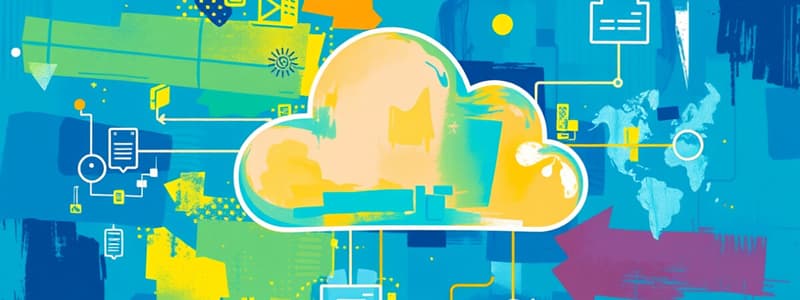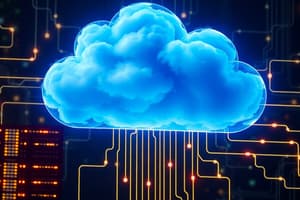Podcast
Questions and Answers
What is cloud computing?
What is cloud computing?
- A network cable
- A method for delivering business and IT services (correct)
- A physical data center
- A software program
What is an analogy used to describe cloud computing?
What is an analogy used to describe cloud computing?
Residential users access electricity through a cable, similar to how cloud computing allows pay-per-use service over the Internet.
What are the components of cloud computing?
What are the components of cloud computing?
Software as a Service, Platform as a Service, Infrastructure as a Service.
Software as a Service (SaaS) means apps and software are in the cloud.
Software as a Service (SaaS) means apps and software are in the cloud.
What is Platform as a Service (PaaS)?
What is Platform as a Service (PaaS)?
Cloud users rent storage, computation, and maintenance from cloud providers (____).
Cloud users rent storage, computation, and maintenance from cloud providers (____).
Which of the following is NOT a basic characteristic of cloud computing?
Which of the following is NOT a basic characteristic of cloud computing?
What is a pure cloud computing service example?
What is a pure cloud computing service example?
What is one advantage of cloud computing regarding document access?
What is one advantage of cloud computing regarding document access?
Cloud computing requires a constant Internet connection.
Cloud computing requires a constant Internet connection.
What is a disadvantage of cloud computing?
What is a disadvantage of cloud computing?
What is the first step in implementing cloud computing?
What is the first step in implementing cloud computing?
Flashcards are hidden until you start studying
Study Notes
Cloud Computing Overview
- Delivers IT services on demand, allowing businesses and users to access needed resources as needed.
- Utilizes network resources, primarily the Internet, for data processing and storage.
Analogy of Cloud Computing
- Similar to residential electricity access: users only pay for the power consumed, with real-time scalability based on demand.
- Cloud computing offers a pay-per-use model, expanding IT resources dynamically.
Components of Cloud Computing
- Software as a Service (SaaS): Applications and software hosted in the cloud.
- Platform as a Service (PaaS): Internet-based platforms provided by cloud vendors for developers without building their own infrastructure.
- Infrastructure as a Service (IaaS): Cloud providers offer datacenter resources including power, hardware, and networking on a rental basis.
Characteristics of Cloud Computing
- No need to understand the underlying infrastructure.
- Flexibility and elasticity allow for scaling resources up or down according to demand.
- Operations are "always on" and accessible from anywhere.
Example Use Case
- Google Drive: A pure cloud service offering online storage integration with cloud applications like Google Docs, Sheets, and Slides, accessible on various devices.
Benefits of Cloud Computing
- Scalability: Resources can be adjusted on demand for efficiency.
- Cost Efficiency: Reduces the need for internal IT resources and management.
- Lower Computer Costs: No need for high-powered PCs as applications run in the cloud.
- Improved Performance: Less memory usage leads to faster boot and run times.
- Instant Software Updates: Web-based applications update automatically, providing the latest versions at login.
- Document Compatibility: Eliminates format issues when sharing documents in the cloud.
- Data Reliability: Data remains stored in the cloud, protecting against local device failures.
- Universal Access: Documents are available anytime with an Internet connection.
- Device Independence: Applications and documents are accessible across various devices without being tied to one specific machine.
Disadvantages of Cloud Computing
- Internet Dependency: Requires a constant Internet connection to access services and documents.
- Slow Connections: Low-speed Internet can hinder usability and performance of cloud applications.
- Limited Features: Web applications may lack the richness of full desktop versions.
- Potential Latency: Web applications might respond slower than local software due to data transfer requirements.
- Data Security Concerns: Risks associated with storing sensitive data in the cloud, including unauthorized access.
Implementation of Cloud Computing
- Involves a five-step process:
- Define and map business and IT services for migration.
- Identify and evaluate potential cloud service providers.
- Select appropriate service providers and platforms.
- Migrate targeted services to the chosen platforms.
Studying That Suits You
Use AI to generate personalized quizzes and flashcards to suit your learning preferences.




